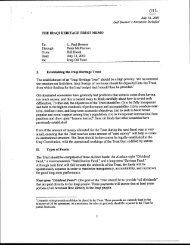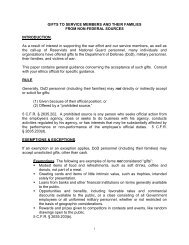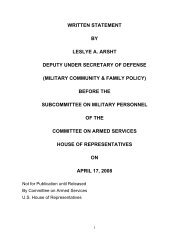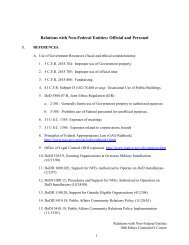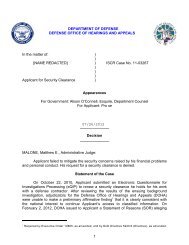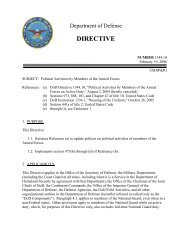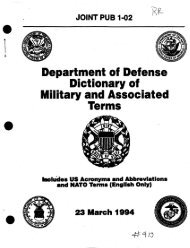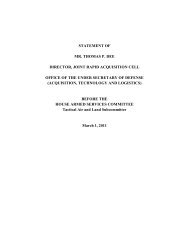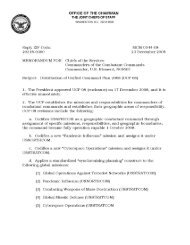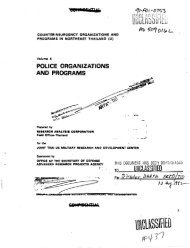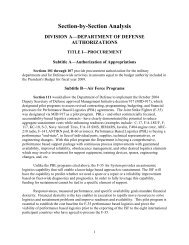dod tactical herbicide sites - United States Department of Defense
dod tactical herbicide sites - United States Department of Defense
dod tactical herbicide sites - United States Department of Defense
Create successful ePaper yourself
Turn your PDF publications into a flip-book with our unique Google optimized e-Paper software.
The History <strong>of</strong> the US <strong>Department</strong> <strong>of</strong> <strong>Defense</strong> Programs for theTesting, Evaluation, and Storage <strong>of</strong> Tactical HerbicidesABSTRACTEarly in 2006, the <strong>Department</strong> <strong>of</strong> Veterans Affairs (DVA) requested that the <strong>Department</strong><strong>of</strong> <strong>Defense</strong> (DoD) provide: “an <strong>of</strong>ficial compilation <strong>of</strong> locations and dates outside <strong>of</strong>Vietnam where the <strong>Department</strong> used <strong>herbicide</strong> agents, including Agent Orange, as wellas locations and dates where DoD personnel were likely exposed to these agents.” Theintent <strong>of</strong> this request was to obtain information that may be important in evaluating themerits <strong>of</strong> many veterans’ disability claims. Various estimates have circulated on theInternet as to the number <strong>of</strong> <strong>sites</strong> where veterans may have been exposed to AgentOrange and “other <strong>herbicide</strong>s” used in Vietnam. There is, however, significant confusionby veterans and by the <strong>Department</strong> <strong>of</strong> Veterans Affairs as to the distinction between“commercial <strong>herbicide</strong>s” used by the DoD and “<strong>tactical</strong> <strong>herbicide</strong>s” used by the DoD.The belief that commercially available <strong>herbicide</strong>s were simply purchased from thechemical companies and deployed directly to Vietnam is incorrect and contrary tohistorical records. Tactical Herbicides were <strong>herbicide</strong>s developed specifically by the<strong>United</strong> <strong>States</strong> <strong>Department</strong> <strong>of</strong> <strong>Defense</strong> to be used in “combat operations.” The history<strong>of</strong> the military development and use <strong>of</strong> <strong>tactical</strong> <strong>herbicide</strong>s dates to World War II. Duringthe Korean Conflict, the DoD developed the first major <strong>tactical</strong> <strong>herbicide</strong>, HerbicidePurple, although it was never deployed. Subsequently, for Vietnam the DoD developed,tested, evaluated, and deployed five additional <strong>tactical</strong> <strong>herbicide</strong>s, Herbicide Pink,Herbicide Green, Herbicide Blue, Herbicide Orange, and Herbicide White. This reportdiscusses the history <strong>of</strong> the development <strong>of</strong> the <strong>tactical</strong> <strong>herbicide</strong>s, how they differedfrom commercial <strong>herbicide</strong>s, and where they were tested, evaluated, stored, used (in thecase <strong>of</strong> Korea in 1968) OUTSIDE <strong>of</strong> Vietnam. Additionally, the report discusses thefinal disposition <strong>of</strong> Herbicide Orange after Vietnam. The report contains 32 leafletsidentifying different locations or multiple locations involved in same projects (e.g.,Leaflet 19 identifies 5 locations in Texas), or the multiple use <strong>of</strong> a specific location (e.g.Eglin Air Force Base, Florida). A total <strong>of</strong> 40 distinctly different locations are identified.For each leaflet, a description <strong>of</strong> the activity is given, an assessment is made <strong>of</strong> theactivity and the individuals involved in the project, and sources <strong>of</strong> the information aredocumented.3



